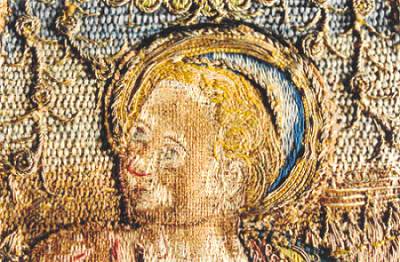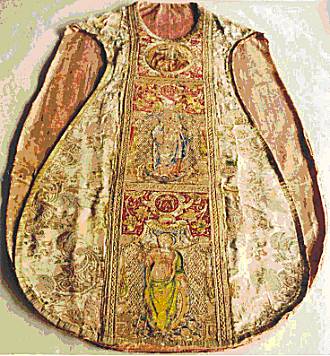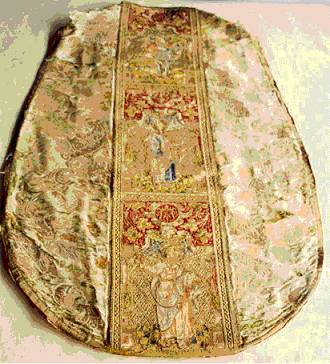
Detail of the St Catherine’ head (3th nich); embroidery stitches:
stem stitch, chain stitch, long and short stitch.
| ANNE WANNER'S Textiles in History / book reviews, articles |
| A
chasuble from the textile collection of the Museu
Nacional de Arte Antiga, Abstract of a paper by Paula Maria Tomaz, in: Conservar Patrimonio, Nr. 1, 2005, p. 55, Instituto Português de Conservação e Restauro, Rua das Janelas Verdes, 1249-049, Tel: ++213 934 200, fax: ++213 970 067, e-mail: ipcr@ipcr.pt |
| Many thanks go to Paula Maria Tomaz for sending the explanatory texts to the pictures, which are taken from the above publication. |
A chasuble from the textile collection of the Museu Nacional de Arte Antiga underwent a laboratorial study prior to the conservation treatment. The analyses gave vegetable fibres for the support layers used in the embroidered strips (orphreys), in the applied embroidered figures, in the volume in-filling threads of those applied embroidered figures, and the intermediate linning support layer. The patterned silk, the back linning, and the embroidery threads of the orphreys are made of ungummed silk. Trough X-ray fluorescence spectrometry the main component of the metallic embroidery threads was found to be silver, although other metals were also detected. These results together with the observations made using a metallographic microscope and a scanning electron microscope suggest that the golden threads should be gold plated silver, which was commonly used between the 15th and 17th Centuries. There is also a description of the condition survey and treatment intervention, which includes the application of an nylon support as a consolidation method on the embroidered figures, opposed to the traditional method, which was thought to be inadequate for the present case. |
 Detail of the St Catherine’ head (3th nich); embroidery stitches: stem stitch, chain stitch, long and short stitch. |
 Detail of the archangel Michael’ head (first nich); embroidery deterioration, face sketched on the line perceptible. |
 The chasuble has two central orphreys, on the front and on the back. The embroidery figures are in applied work and the background is covered with direct embroidery with silk and metallic threads, 16th century, Spain (?). Late 17th French fabric. |
 Back of chasuble. |
| home content | Last revised 28 April 2007 |
|